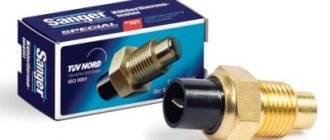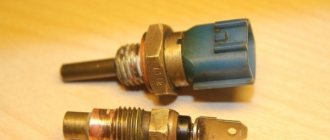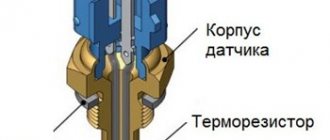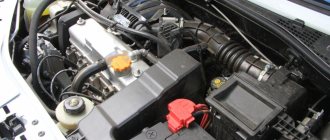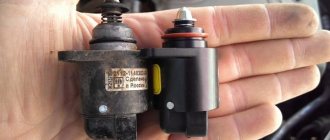For the cooling system of any car, including the popular Lada Priora, it is not the most pleasant moment to be stuck in a traffic jam for a long time. When the car moves without long periods of downtime, the temperature load is removed by the oncoming air flow. There is no such flow when idling. When overheating, the radiator fan automatically turns on, but only if the coolant temperature sensor is working properly. This is a very necessary functional device for a car. If the sensor does not work, replacement is required. In this material we will analyze in detail how the device works and where it is located. No less useful will be information on how to change this sensor on a Lada Priora. To replace, you will need a certain set of tools; such a tool is not a problem for a hundred; it is available in any car service center.
Coolant temperature sensor (fan on) and its purpose
A temperature sensor or DTOZh is a part that is included in the engine cooling system and controls the process of warming it up. This element does not display the corresponding temperature values on the instrument panel, since another device is responsible for this action (temperature sensor on the DUTOZH arrow). DTOZH sends a signal to turn on the fan to cool the radiator (at a temperature of 98 to 107 degrees), through which liquid circulates. That is why such a device is often popularly called a fan sensor. However, its correct name is DTOZH or coolant temperature sensor.
In addition to turning on the fan, the DTOZH on the Priora performs another very important function. It consists of adjusting engine operation by changing the composition of the fuel-air mixture and setting the ignition timing. This is achieved by connecting the sensor to the electronic control unit. A corresponding signal about the engine temperature is sent to the ECU from the DTOZH, and depending on the incoming readings, the engine operation is adjusted. It looks something like this:
- When starting the engine cold, the ECU receives a signal that the engine has not warmed up to operating temperature (i.e., cold).
- The control unit makes a decision on preparing fuel assemblies in a certain proportion. To do this, a signal is sent to the idle speed regulator, which opens the XX valve to the appropriate distance (a certain number of steps), which leads to an increase in crankshaft speed. To quickly warm up the engine, more fuel is supplied through the injectors, and the ignition angle is also adjusted.
- When the coolant temperature rises to a certain value, the engine speed is reduced and the mixture composition is adjusted.
If on carburetor cars only liquid temperature sensors are used to display information on the dashboard, and they do not affect the operation of the engine, then on modern injection engines two types of devices are installed. If the coolant sensor is faulty, the engine will most often start and it will run, but the fuel assemblies are prepared according to average values in emergency mode (the computer, if there is no signal from the DTOZH, takes the temperature of the internal combustion engine as 0 degrees). This also turns on the fan, which cools the liquid in the radiator to eliminate the possibility of overheating the engine (since the ECU does not see the actual engine temperature).
Typical signs of a device malfunction are the following:
- unpredictable operation of the cooling fan. If a break occurs in the electrical circuit, which happens due to damage to the supply wire or sensor contacts, the fan will operate continuously
; - floating speed, since the faulty element gives incorrect signals, as a result of which the ECU will strive to adjust the optimal mixture ratio;
- The Check Engine light comes on, indicating an engine malfunction.
It is important not to confuse the coolant temperature sensor on the Priora with the element that is responsible for displaying information about the temperature of the internal combustion engine on the instrument panel. These are two different sensors that have a similar operating principle, but are responsible for performing different functions. If there is a malfunction of the device that displays the engine temperature value on the instrument panel, the CHECK indicator will not light up.
This is interesting! On the Priora, the DTOZH has two contacts, and there is only one sensor per arrow. The operating principle of the devices is the same, and the only difference between them is that on the DTOZh the resistance is measured between the terminals, and on the pointing device - between the body and the contact.
Goods and services in Moscow - portal Moskva.tiu.ru
Speed sensor VAZ 2170-2172 Priora, 1117-1119 Kalina (2011-) BAUTLER
Speed sensor 2170-3843010 (02170-3843010) SOATE
Speed sensor 2170-3843010 (533.3843) Kaluga "AutoTrade"
Coolant temperature sensor "AutoTrade" 1118-3808600.2170 (27.3828AT)
Clutch release sensor 1118-3720015 (2170,2190) set 5pcs.
Mass air flow sensor BOSCH - 2110-2112-2170 (0 280 218 116)
Mass air flow sensor BOSCH - 2170 (1118,2123) (control M17.9.7) (0 280 218 225)
Catcollector 11183-1203008-00 (8 cells) 2 sensors (RosKat) round
Throttle position sensor 2112-1148200 Pekar
Catcollector 21116-1203008-20 (8 cells) 2 sensors Eberspächer Germany
Crankshaft angle sensor 2110 (191.3847) AvtoKom Kaluga
Crankshaft angular position sensor 2110 (30.3847 IU (191.3847) EMI Penza
Throttle position sensor 2112-1148200 SOATE (02112.1148200)
Lighting control unit 2170 LUX 12V (522.3769) AVAR Pskov
Reverse switch 2170-3710410 (1118) VZH-7 (1332.3768) Penza EMI
Antifreeze level sensor 2110-3839310-13 (small) 64.3855-01 EMI Penza
Eng.Oil level sensor 21083-3839210 Eng.metal. (64.3855-03) EMI Penza
Phase sensor (camshaft position) 8kl. 2111-3706040 (48.3855) AutoTrade Kaluga
Phase sensor (camshaft position) 16kl. 2112-3706040-01 (4102.3847) EMI
Canister valve 2112-1164200-02, GAZ Euro-2
Mass air flow sensor BOSCH - 2112 (0 280 218 037) Gazelle, Sobol, Volga doors. 405,406
Eng. Idle air regulator 2112-1148300 (VSM 0112) StartVolt
Ing. Idle speed regulator 2112-1148300-04 (02112-1148300-04) SOATE TM
Adsorber valve 21103-1164200-02 (16kl.) Euro-3
Speed sensor 2108-2110 without wire (02111.3843010) SOATE
Speed sensor 2110 (35172.03) with wire round connector
Speed sensor 2110 (301.3843) with wire, square connector 6 imp.
Split gears 16V steel with phase sensor Lada Priora, VAZ 2170, 2171, 2172
Coolant temperature sensor for VAZ 1117-19, VAZ 2170-2172 “Pekar” cars
Timing gears split 16V steel with phase sensor SPORT VAZ 2170, 2171, 2172
Reverse gear sensor for VAZ 2170-2172 “Pekar”
Coolant temperature sensor VAZ 2110-2115, Kalina, Priora, Niva Chevrolet (with ECM) LUZAR LS0112
Oxygen sensor fake Lada Priora VAZ 2170, 2171, 2172
Extension oxygen sensor Lada Priora VAZ 2170, 2171, 2172
Coolant temperature sensor VAZ 2107, 2108, 2112, Niva Chevrolet (with ECM) KALUGA 423.3828 pcs
21720-3724248 Parking sensor harness
Mass air flow sensor (MAF) since 2005 VAZ 2109-2115, Kalina, Priora, Niva Chevrolet HOFER HF218116
Coolant temperature sensor VAZ 2113-2115, Lada Kalina, Priora, Niva Chevrolet HOFER HF750930
Coolant temperature sensor VAZ 1117-1119 Kalina, 2123, 2170-2172 Priora (2008->), n/a
21703-8121210 Outside temperature sensor Korea
The principle of operation of the DTOZH on Priora: how the fan switching device functions
The design of the element in question is based on a semiconductor element - a thermistor. When the temperature applied to the thermistor changes, the resistance increases or decreases. Below is a cross-section of the design of the temperature sensor, which will help you understand the principle of its operation.
Such an element is connected to the circuit using two contacts. Changes in temperature change the resistance, and as a result, the voltage in the circuit increases or decreases. The ECU records changes in voltage (drop), and depending on its value, makes appropriate decisions about preparing the mixture and adjusting the ignition. A voltage of up to 5V is supplied to the sensor from the controller through a 2 kOhm resistor, and depending on its fluctuations (drops), the electronic unit determines the engine temperature at the corresponding moment in time.
Location and characteristics
On the Priora, the sensor is located on the cylinder head on the right side near the thermostat (it is located above the flywheel housing in the engine block). Its connection is made directly to the engine control unit. It is there that he sends all the information about operating temperature indicators.
A specific feature of this car is the presence of two detectors that are not connected to each other. One works only with the instrument panel and transmits measurement information to it. The second coordinates its work with the car’s on-board computer. It is possible to comprehensively ensure high-quality engine operation, which is achieved by including additional cooling systems.
Types of engine temperature sensors: what type is used on Priora
It is important to understand that there are two types of engine temperature sensors. They differ in the principle of operation, and you need to know the operating features in order not to make a mistake when choosing such an element for your car. The following types of DTOZH are distinguished:
- With a negative temperature coefficient
(NTC - negative temperature coefficient) - it works as follows: when the temperature rises, the resistance decreases, and vice versa. - With a positive coefficient
(PTC - positive temperature coefficient) - it has the opposite principle of operation. When the temperature increases, the resistance increases.
The most common types are negative temperature devices. It is these sensors that are used on Priora cars.
When the engine is cold, the maximum resistance of the Priora DTOZH thermistor reaches 100.7 kOhm (this value will be at a temperature of -40 degrees). When the engine warms up, the temperature increases, which means the resistance drops. At a high temperature of +130 degrees, the thermistor resistance is about 70 Ohms. These readings are the operating range. When the engine is cold, the voltage drop in the circuit will be large (drops to 18%). As it warms up, it will increase (up to 90%).
This is interesting! If the engine is cold, then the voltage in the circuit will be about 3.4V, and when it warms up, the value decreases to a minimum (0.15V). It is important to know what type of sensor is used on the car in order to diagnose it and check for serviceability or correct operation.
Methods of testing for functionality
Two devices will help you monitor the output parameters:
- digital oscilloscope with memory function;
- voltmeter with electronic scale.
You need to focus on a value of 3 V. When the motor warms up and the temperature increases, the voltage will drop to 1.3-0.5 V. On the oscilloscope, these values should be reached in 4-5 minutes.
When the testers show a voltage less than 5 V, this indicates a loss of reference voltage or a short circuit. Some sensors are equipped with a maximum/minimum function. During testing, they will experience sudden voltage surges as the temperature rises. On the obtained oscillogram data, shorted moments will appear as a drop to zero, and breaks in the circuit will be indicated by an increase in voltage to 5 V.
In the case when the output parameters of the DTOZH correspond to the norm, and the temperature in the system does not return to operating mode, the cause of the malfunction most likely lies in the thermostat. Its circuit remains in the open position, and the refrigerant does not heat up to the temperature set by the automaker.
Characteristic signs of DTOZ failure on Priora: reasons for increased consumption
The engine temperature sensor or fan activation sensor is one of the main executive elements of the control unit. The malfunction of such a device entails incorrect operation of the engine, and the consequence of such a breakdown “hits the wallet”, because fuel consumption increases significantly. Due to the fact that the DTOZh performs a very important function, measuring the engine temperature and transmitting information to the electronic unit, such a device rarely fails. This means a complete malfunction of the sensor when the Check Engine lights up on the instrument panel and the following error codes are displayed on the on-board computer:
- P0115 - malfunction of the electrical circuit of the DTOZH;
- P0116 - sensor error in the form of values falling outside the permissible range;
- P0117 - low signal level at the DTOZh output (the ECU receives a voltage below 0.14V from the sensor);
- P0118 - increased signal level from DTOZH (output voltage over 4.91V);
- P0119 - unreliable sensor contact. Typically, this error is displayed if the signal from the device is interrupted.
There are the following types of malfunctions of TOZh sensors that are found on Priors:
- Over time, the thermistor begins to show incorrect temperature values, that is, it lies. You can verify this using a multimeter.
- Chafing of wires near the sensor connector, which also leads to its incorrect operation.
- Reduced insulation quality.
Characteristic signs that the element in question is out of order or it is “jamming” are the following manifestations:
- when cold, engine speed drops;
- lack of idling or floating speed;
- unstable operation of the internal combustion engine;
- impossibility of starting the engine when hot (due to DTOZh failure);
- turning on the fan, which is usually accompanied by error P0115.
This is interesting! However, the most common type of DTOZ malfunction on a Priora is when the cooling fans turn on and off for no apparent reason, that is, on a cold engine or if the temperature has not reached the switch-on value.
The consequence of a malfunction of the device is increased fuel consumption to 10-15 liters per 100 km. Operating a car with a faulty DTO is strictly contraindicated. If signs of its malfunction are identified, you should immediately resort to diagnosis or replacement.
Where to buy car accessories
Spare parts and other products for the car are easily available for purchase at auto stores in your city. But there is another option that has recently received significant improvements. You no longer need to wait a long time for a parcel from China: the AliExpress online store now offers the opportunity to ship from transshipment warehouses located in various countries. For example, when ordering, you can specify the “Delivery from the Russian Federation” option.
Follow the links and choose:
| Eunavi 12V universal car auto door lock | YASOKRO car parking sensor, parking sensor system with 4 sensors | Car windshield projector GEYIREN M8 |
| Parking assistance system GSPSCN | Car Rear View Mirror 4.3 inch CCD | Radar detector, voice notification, 360 |
Where is the coolant temperature sensor installed on the Priora?
Many car owners do not know where the element in question is located on Priora until they are faced with the need to diagnose or replace it. In order not to make a mistake and correctly find the coolant temperature sensor on the Priora, below is a photo of its location. It is located between the cylinder head and the thermostat.
Access to it is almost free, but for ease of diagnosis or removal, it is necessary to dismantle the air filter housing. It is important not to confuse this element with the device responsible for displaying temperature readings on the instrument panel. In the design of the Priora cooling system, two temperature sensors are installed: one on the arrow (it is located below), and the second on turning on the fans and transmitting readings to the computer.
Operating principle
DTOZh "Priora" is installed directly in the thermostat housing. This allows for maximum pulse accuracy. Since DTOZH is always in contact with antifreeze, it can almost instantly detect the slightest changes in temperature. It also quickly transmits signals to the ECU. Based on the information received, the car’s brain adjusts the engine operating parameters, changing the composition of the fuel mixture.
If the antifreeze level is too low, the controller will receive incorrect data and the engine may run rough. This is also observed due to sensor failure.
Coolant temperature sensor on Priora: technical parameters
The cost of DTOZh on Priora is about 200-400 rubles. Products are produced by different manufacturers, but the most popular are Luzar devices. The coolant temperature sensor on Priora has article number 23.3828.
It comes in a cardboard package along with an O-ring (copper or steel washer), which is important not to forget to put on the thread when installing. Below are the technical parameters of the sensor.
Characteristics of Priora DTOZH
Before installing a new product, you can check it by measuring the resistance value. This will ensure that you have not purchased a defective product. How the replacement is performed is described in detail below.
Diagnostics
To check the DTOZH in a garage or at home, you will need a container with coolant. You also need a thermometer that can accurately measure temperature up to 120 degrees.
It is necessary to replace the sensor resistance in different temperature conditions. Antifreeze must be heated during the diagnostic process. The data obtained on the multimeter is compared with the temperature on the thermometer.
How to remove and replace the coolant temperature sensor (fan on) on a Priora
The process of replacing the sensor is not complicated, but before implementing it, it is important to know the following: before unscrewing it, you should unscrew the cap of the expansion tank and relieve the pressure in the cooling system. After this, you can begin dismantling work, but it is also important to take into account that after unscrewing the product, antifreeze will flow out of the installation hole. According to the manual, it is recommended to drain antifreeze from the radiator in an amount of at least 1 liter, but practice shows that if you relieve the pressure in the system and quickly replace the device, a small amount of liquid will leak out.
This is interesting! It is important to understand that if you are working on a warm engine, you need to either wait until it cools down or drain the antifreeze so as not to get burned in the process.
The process of replacing DTOZH on Priora is carried out as follows:
- Disconnect the negative terminal from the battery. Why do this? Naturally, no one is going to short-circuit the contacts, and the likelihood that they will close when in contact with metal parts of the engine is extremely low. However, after removing the sensor, antifreeze may get on the chip, and if there is voltage on it (there is none when the ignition is off), the ECU may short out. And therefore, if you do not disconnect the terminal from the battery, then after removing the chip, move it to the side so as to eliminate the possibility of a short circuit. However, to reduce the risk, it is better to disconnect the terminal on the battery.
- To make work easier, it is recommended to remove the air purification filter housing.
- After draining at least 1 liter of liquid from the cooling system (if you decide to go the right way), you need to disconnect the power supply. To do this, you need to pull back the tongue and remove the chip.
- Unscrew the sensor with an open-end wrench to “19”, and if liquid leaks out of the hole, quickly install a new sensor in place, having previously prepared it.
- When installing, do not forget about the copper washer.
- Tighten the sensor with a force of 9.3-15 Nm using a torque wrench.
This completes the process of replacing the fan sensor on the Priora. All that remains is to reset the errors from the BC and make sure that the engine is working properly, as well as the absence of signs that forced you to check and replace the DTOZH.
How to make a replacement yourself
Replacement of the Lada Priora DTOZH is carried out only after the preparatory work described above. For this purpose, disconnect the wires from the part along with the terminal and unscrew it. The most convenient way to do this is to use a 19 mm deep socket. As soon as the sensor begins to give in, it is unscrewed and removed manually.
Sequence of actions when replacing a temperature detector:
- Find the negative wire and remove it from the battery;
- A little antifreeze needs to be drained;
- Press out the plastic clips;
- Disconnect the wires;
- Loosen the tension a little and carefully unscrew it;
- Replace the sensor and perform all steps in reverse order.
- Add antifreeze back.
Change this spare part at least once, and it will become clear that the procedure does not present any particular difficulties.
Signs of breakdown
Like any other part of the mechanism, the DTOZH in Priora periodically becomes unusable. It happens that the cause may be a broken indicator on the device, problems with the wiring, or a malfunction of the sensor itself. The following symptoms may indicate a malfunction:
- continuous operation of the fan, which is designed to cool the engine - in this case, the machine will operate in emergency mode, and a constantly running mechanism will lead to burnout of the winding in the motor, which in the future will require a complete replacement of the unit;
- the cooling fan does not turn on - in this case, increasing overheating of the engine will lead to boiling.
There are also indirect signs that may suggest a problem with the detector:
- reduction in vehicle power;
- presence of hum from constant operation of fans;
- increase in consumption;
- The engine often stalls and is difficult to start.
Symptoms of malfunction
The sensor exhibits the following malfunction symptoms:
- The car's dynamics disappeared;
- The temperature readings are no longer displayed on the dashboard;
- The car is idling unsteadily;
- Jerks appeared when driving at constant speeds;
- There are no increased speeds when starting the engine;
- The cooling fan does not work;
Based on these signs, it can be assumed that the DTOZH is out of order or is giving incorrect readings.
Gazelle (engines ZMZ 406, 405, 409)
Installation location - on the power unit in the area of the thermostat or on the body of the latter.
To remove it, it is necessary to partially drain the coolant from the engine, disconnect the spring clamp of the harness block and discard the block from the sensor.
Next, using a key set to “19” you need to loosen the broach and unscrew the device.
When choosing a device, you need to focus on the engine and ECU.
406 engine and ECU Mikas 7.1, 5.4, SOATE, VS5.6
In such cases, a DTOZH is used, operating at a voltage of 5 to 12 Volts through a resistance of 9.1 kOhm.
Several types of devices are suitable for replacement: Kaluga 19.3828, Luzar LS 0306, Rikor 40.5226 or Autotrade 42.3828.
When checking, you will also need water with a boiler and variable temperature, as well as a multimeter.
To work, you need to assemble a circuit and apply 1 to 1.5 mA to it. In this case, it is necessary to measure not resistance, but voltage.
When checking, the following parameters must be present:
- -60 0С - 2.13 V;
- -40 0C - 2.33 V;
- -20 0C - 2.53 V;
- 0 0C - 2.73 V;
- +40 0С - 3.13 V;
- +80 0С - 3.53 V;
- 105 0C - 3.83 V;
- 125 0C - 3.98 V.
When the engine is running, the voltage will be 5 V.
Engine 405, 409, UMZ 4216E3, 4213 control unit Mikas 11 / 10.3, VS8, SOATE
DTOZH with catalog numbers 234.3828, 40.5215 or 421.3828 are used here.
Unlike the method discussed above, here it is necessary to measure resistance.
In this case, the dependence should be as follows:
- 128 0C - 80.8 Ohm;
- 100 0С - 177 Ohm;
- 80 0С - 332 Ohm;
- 60 0С - 667 Ohm;
- 40 0С - 1459 Ohm;
- 20 0С - 3520 Ohm;
- 0 0С - 9420 Ohm;
- -20 0С - 28680 Ohm;
- -40 0С - 100707 Ohm.
In case of significant deviations from these parameters, the device must be replaced.
VAZ 2114, VAZ 2115
On these cars, GM 2112-3851010-01 can be used as a DTOZH. The location of the device is between the cylinder head and the thermostat.
To check, it is recommended to dismantle the element (open-end wrench size 19). To do this, you need to wait until the engine cools down, reset the negative voltage on the battery and drain the antifreeze.
After this, you need to dismantle the device and check it by heating the liquid, a thermometer and a multimeter.
The following parameters must be present.
Table 2.
| Temperature, 0C | Resistance, Ohm | Voltage, V |
| +30 | 1350-1880 | 8 |
| +50 | 585-820 | 7,6 |
| +70 | 280-390 | 6,85 |
| +90 | 155-196 | 5,6 |
| +110 | 87-109 | 4,7 |
If there is a discrepancy in the readings, the device must be replaced.
